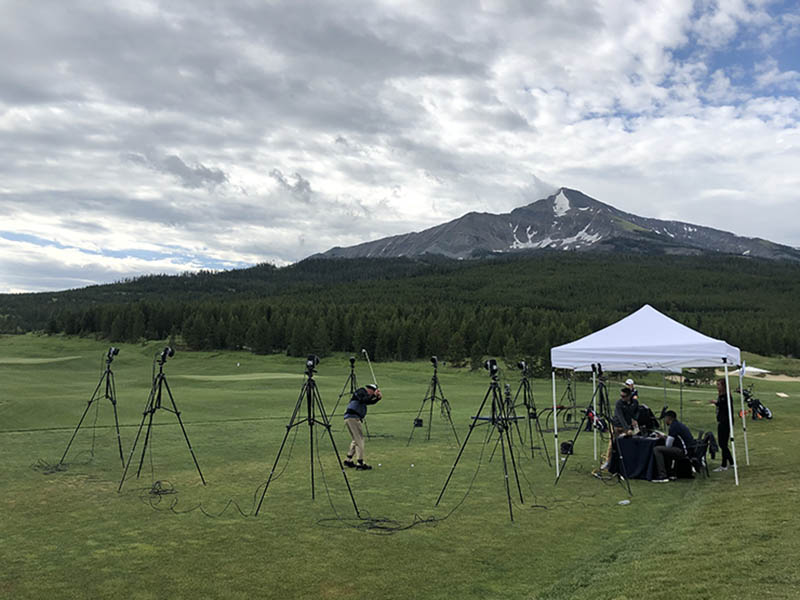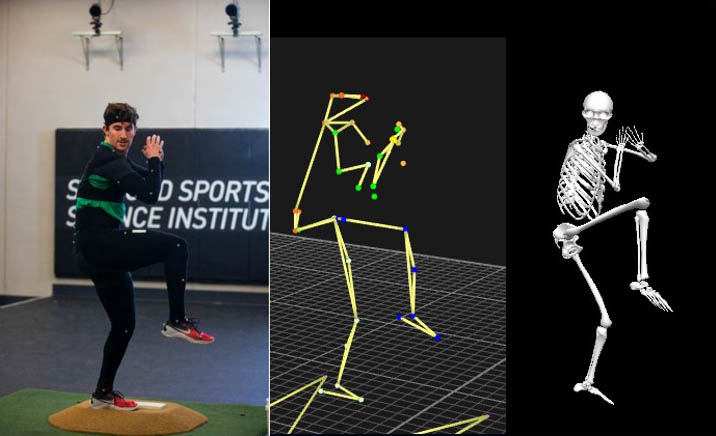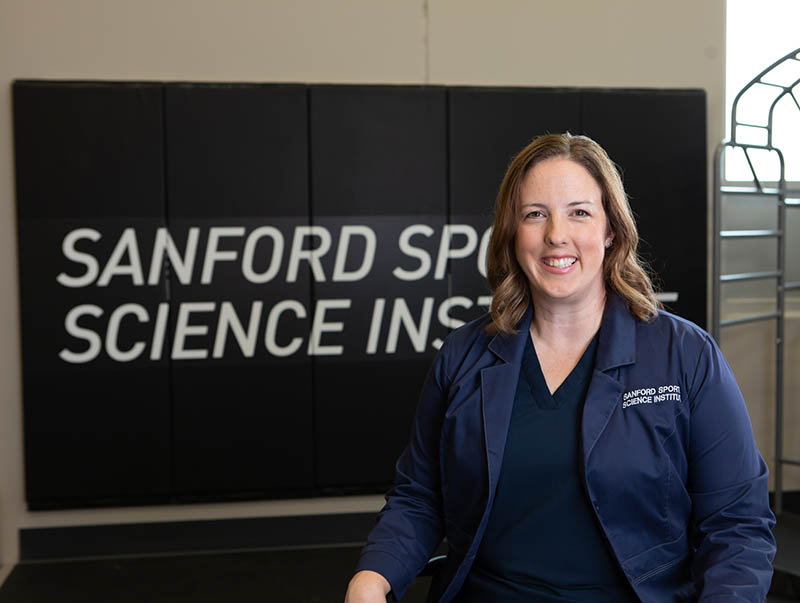Scientific research doesn’t always involve wearing a white lab coat and scrutinizing cells under a microscope.
Sometimes, research involves handing someone a golf club and evaluating how they swing it.
When Upstate New York native Lisa MacFadden pursued her Ph.D. in biomechanical engineering in Utah, she didn’t picture that her science career would eventually center around sports at a health system in South Dakota.
“I don’t think I saw any of this coming,” said MacFadden, who leads the Sanford Sports Science Institute among her roles with Sanford Health. “It’s just been looking at exciting opportunities as they present themselves and following the adventure as we go.”
Here’s a look at MacFadden’s adventure so far — and what she looks ahead to in the future.
Ski racer wanted to be a doctor
MacFadden and her husband grew up in a town roughly the size of Brookings along Interstate 90 in New York. Moves to larger cities came in between, but the move to Sioux Falls a few years ago is “kind of like being home,” she said.
MacFadden enjoyed ski racing and tennis growing up. She’s also a rock climber. Golf would come later, after arriving to work at Sanford Health.
She initially dreamed of being a doctor. Her dad was a doctor; however, he thought she should be an engineer. Still, she started college pre-med with a major in applied math. Eventually, though, she realized the lifestyle of a doctor wasn’t quite what she wanted.
“I was already basically an engineer, so I finally caved in and became an engineer,” MacFadden said.
Biomechanics, specifically — looking at the movement and structure of living things — suited her. And an event during college cemented her interest. She watched a ski racing qualifier in which people with disabilities raced down the mountain on adaptive equipment, then shifted back into their wheelchairs after the race.
“They were these amazing athletes who have these disabilities in their day-to-day life. So for me, that was just eye-opening,” MacFadden said.
“I got into biomechanics and robotics in graduate school because I really wanted to make a difference for people in their day-to-day lives.”
Her Ph.D. work studied spinal cord injuries. Then after graduating, she worked in San Diego for the military on physical performance and musculoskeletal injuries.
Now, her technical background combines with her leadership experience — which ranges from high school fundraising to overseeing project teams — in an ideal blend for the variety of roles she has acquired at Sanford Health.
Integrated science lab
From a research standpoint, MacFadden focuses on orthopedic biomechanics, sports performance biomechanics and sports medicine. She runs Engineering and Applied Sciences for Sanford Orthopedics and Sports Medicine, where she oversees the Sanford Sports Science Institute. That also explores innovations in sports performance and sports injuries, along with testing services and education programs such as the orthopedic residency program and sports biomechanics at the Department of Biomedical Engineering at the University of South Dakota.
Research projects can range from ACL tears to concussions to total joint biomechanics, along with improving performance and reducing injury risk in sports ranging from baseball to volleyball.
MacFadden’s research diverges from traditional bench science in its ability to often be applied in real time to real people.
Integration is key to making this happen. To illustrate this, consider the Sanford POWER Golf Academy. It’s a timely example, considering the academy’s new home is the Great Shots golf entertainment facility, which just opened at the Sanford Sports Complex.
Related: Great Shots impressed those getting their first look
The POWER Golf Academy lab on the ground floor offers much more than entertainment. The spacious lab includes “greens” and plenty of technology to help evaluate things like mobility, strength, power and more. Force plates, as one example, measure how people’s feet interact with the ground. Sharing the space are golf instructors, strength and conditioning coaches, physical therapists — and the researchers.
“We’re really just embedded all the time with our clinicians and our coaches,” MacFadden said. “And when you’re all talking about, ‘Hey, there’s a problem here’ … that’s where ideas come from. So us just having that opportunity is where we drive our innovation.”
Enlarge

Golf research: ‘Impact in real time’
Anyone from a high school golfer to a professional might seek insights at the POWER Golf Academy. Working with physical therapists who are evaluating the golfer’s movements, a researcher like Aaron Trunt can collect data at the same time. He can, in turn, work with Sanford Health golf instructors to explain the data and help them apply research findings.
“We’re not doing research that gets put on a shelf,” MacFadden said. “We’re doing research that is having an impact in real time. Our subjects learn something about how they move, or they learn something about their athletic history, or their capabilities. … But then beyond that, we have the ability to make real-time changes and implement new things.”
The Concussion-Return to Play program is one example of research turning into a tool used by clinicians to safely return athletes to their sport. Another tool from research is the Sanford Score, which assesses overall athleticism into one number, which help quantify progress. Both programs are used by Sanford POWER and were developed by Sports Science Institute researcher Thayne Munce, Ph.D. Researcher Aaron Trunt, a Ph.D. student mentored by MacFadden, is developing an Upper Extremity Return to Play program. These are all possible because of the collaboration between clinicians and researchers.
“It’s a great cycle collecting data to inform practice to drive research. As we learn more and more, we get new ideas,” MacFadden said.
Opening up possibilities
The progression with golf began with looking at how strength and conditioning influence performance, along with ground reaction forces. Then Trunt did his master’s thesis research at Sanford Sports Science Institute on hip mechanics as it relates to performance.
With the new area for the POWER Golf Academy, MacFadden expects research to look at athlete development. “We can take measurements on the Golf Academy participants and seeing how they develop over time. For example, we’ll have opportunities to look at injury history and injury outcomes and movement assessments,” she said. The physical therapists’ evaluations of movement and range of motion will help with that. The scientists can examine the improvements in performance and in pain.
“What’s really unique is that we actually have the ability to look at performance, clinical, testing, development,” MacFadden said. “Since we’re engineers, we create things, too, so we’ll create new ways of testing and analyzing things. We hope to also work with equipment manufacturers eventually.”
Golf club manufacturers, for example, could benefit from data that would help them understand exactly how people move. “Part of how you move, too, is what you hold,” MacFadden said.
Enlarge

Motion capture: ‘We use that to get nerdy about the math’
While MacFadden’s golf game is pretty new, her past athletic experiences have helped her relate to other athletes. “If you’ve never experienced loads on your body, you don’t know what you’re measuring,” she said.
“Tons of different forces and energies go into the way that you ski and the way that you use your equipment and all of those things. Understanding that helps me to understand the similarities if I’m looking at golf equipment,” she added.
MacFadden’s favorite technology in the lab at the moment is motion capture, for its versatility in gathering data and its application in many sports.
“It’s our camera system,” she explained. “We put markers on people — on bony landmarks — and then it’s like what they use for video games and computer graphics in movies. Except we use that to get nerdy about the math behind how people move.”
It’s not too difficult to find subjects to study, especially if the research involves sports improvement.
“When we had recruits last winter, you’d be surprised how many people just want a place to hit balls,” Trunt said. “If you say, ‘You can come get 10, 15 swings in,’ they’ll come.”
MacFadden and Trunt work with university athletes, too, because of the relationship Sanford Health has in providing sports medicine services to regional universities. And patients who are interested in being part of a medical study are welcome, too.
Hosting conference will showcase lab
MacFadden has led the Sanford Sports Science Institute to national prominence, with she and others presenting at conferences. And in 2021, the Sanford Sports Complex, including Great Shots, will host the 10th World Scientific Congress of Golf. The international conference will gather golf instructors and people in the industry and in academia that September, immediately after the Sanford International PGA Champions Tour event ends.
MacFadden said the last World Scientific Congress of Golf, where she gave a presentation, had 11 countries and four continents represented. She’s hoping for a similar turnout in 2021.
Holding conference workshops in Great Shots, she expects, will allow participants to actually try out points — such as a certain grip — that presenters talk about, rather than passively watching a slide show.
“We have the opportunity to educate on a grand scale,” MacFadden said.
“We don’t know of anybody out there that’s got this whole integrated team approach.”
At the same time that she’s furthering the research and reputation of the Sanford Sports Science Institute, she also feels strongly about introducing her career field to high schoolers. To help make it more accessible to them, the institute hosts National Biomechanics Day every year.
“We open up our facilities to high school students in the region and bring them in and leverage sports to get them excited about it,” MacFadden said.
Biomechanics, she said, used to be relegated to a university basement lab. Now it’s on football fields and golf courses. It’s helping people improve. It’s keeping them from getting injured, and it’s helping them recover from injury.
“We’re trying to make this mainstream,” she said, “because we believe that this is something that can impact people and improve their quality of life.”
More stories
- How strength and conditioning can impact your golf swing
- Bernhard Langer finds answers with Sports Science Institute
- Golf scientists trade findings at World Scientific Congress
…
Posted In Brookings, Golf, Orthopedics, Research, Running, Sanford Sports, Sanford Stories, Sports Medicine
